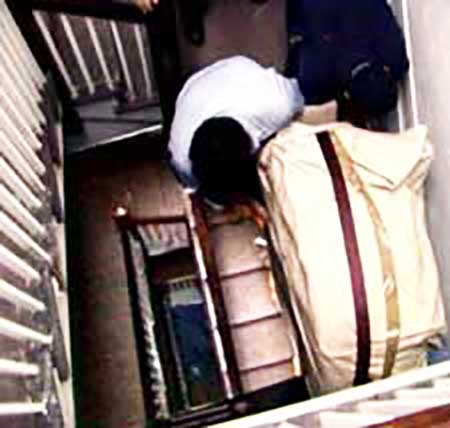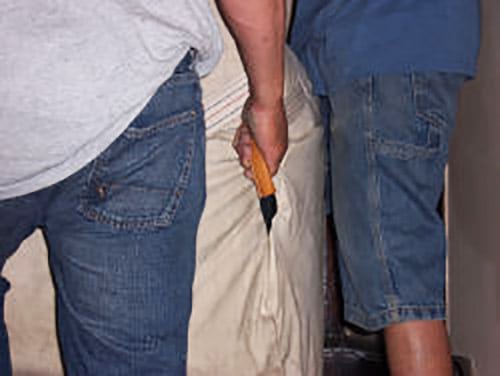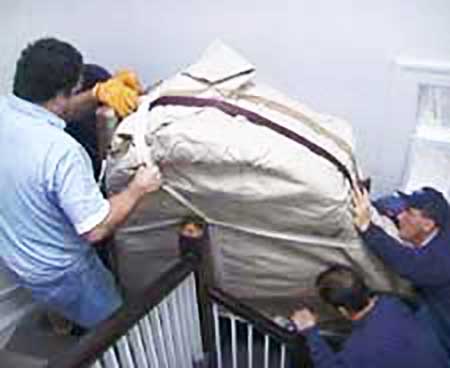Large grand pianos are quite heavy, even more so than large upright pianos because most of the weight of any piano comes from its cast iron harp inside of its body.
The smallest grand piano starts at 54 inches long (which is equivalent to a 54 inch high upright piano at 500-600 lbs.) and they can extend out to 108 inches long for a 9′ concert grand, topping out at 1000-1200 lbs.
So grand pianos can weigh anywhere from 500 to 1200 lbs. Most grand pianos are 4 1/2′ to 6’4” long so they weigh in between 500 and 800 lbs. But longer
We recommend that amateurs do not move 6′ or larger grand pianos because of their extreme weight.
Determining the number of people needed to move a Grand Piano
The longer the grand piano – the heavier it is because most of its weight comes from the cast iron harp that holds the strings in place. Cast iron is extremely heavy material so the longer the grand piano – the bigger the harp – the more it weighs and the more it weighs – the more people you need to move it.
For amateurs; at least 4 or 5 people should be used to move a 4 1/2 to 5 foot grand piano. On a bigger grand piano; have at least 5 or 6 people on the crew. Amateurs should never move grand pianos bigger than 6′ long.
How to prepare a baby grand piano for moving
To prepare a grand piano for moving, first, lift off its music rack and remove its lyre. Then its legs all need to be removed and it needs to be securely strapped in its side to a piano
The keyboard (referred to as the piano’s action) should only be removed by a qualified piano technician. In most cases, when moving a grand piano the keyboard action need not be removed. So, ask your piano tuner what they would recommend for your particular piano.
Below is a picture depicting the removal of a grand piano’s lyre. This task is fairly easy because it involves just unscrewing and removing the lyre-pedal assembly from the underside of the piano.

Only the lyre-pedal assembly with its two wooden push rods needs to actually be removed from the piano (the picture below shows a rectangular, light spot on the wood with the 3 screw holes where the piano’s lyre-pedal assembly has been removed).

The other pieces of the mechanism can remain attached to the underside of the piano (as is shown above) because they don’t bulge out much. The idea here is to make the grand piano flat underneath so that when it’s tipped up onto its side upon the piano
Then it will fit nicely
To fully accomplish that goal, it is, of course, also necessary to remove the piano’s legs.


How to move a baby grand piano
The piano, bereft of its music rack, lyre, and legs, padded and covered (optional) and strapped onto a padded piano

Converting a grand piano from its playing position (sitting on its 3 legs) into this moving position (well balanced upon a dolly) without damaging it nor breaking a leg or the lyre is not the easiest thing in the world to do. Disassembly and dolly mounting techniques all need to be correctly accomplished in order to make this happen successfully.
You can carry and/or dolly the piano to its destination with a minimum chance of scratches and/or scrapes when it is disassembled and set up in this manner. If you want to really go all out, you could also rent or buy an expensive piano cover (as shown in the action pictures below) by which to more easily grip the piano as you carry it over stairs.



It’s a great piece of equipment to have because when it covers the piano properly at the base of the piano, it will provide many handholds that can be easily gripped.
Don’t forget to go over the other piano moving tips before planning your move. It is a good idea to get a moving price quote for your move so you can decide whether it is better for you to go with a moving company.
Grand Piano Moving Cost
Grand pianos are usually very large and heavy – they require more people and more specialized equipment to be relocated from one place to another and often need to be partially dismantled to be taken safely in or out of the home. Therefore, they’re much more expensive to relocate than upright pianos.
The cost to move a baby grand piano is determined by the distance between the pick-up and delivery locations and the required extra services (disassembly, crating, hoisting, storage, etc.).
Professional piano movers typically have a base rate of $50 to which they add mileage at an average rate of about $1.50 per mile for local moves and $3 per mile for long distance moves and extra charges for steps, stairs, and other obstacles.
So, how much does it cost to move a grand piano? The average piano moving cost is about $400 for local moves (though the price can vary from as little as $250 to as much as $650, depending on the specific type of the piano and the hardships the movers have to overcome when taking the instrument out of its old home and into its new one) and $2,000 for long-distance relocations.
When you think about it, the cost is worth it – hiring professional piano movers will ensure that your valuable grand piano arrives at your new home in excellent condition and will save you a lot of time, effort, and headaches.
See also: How much does it cost to move a piano?
Is it worth it
It may cost a lot to have your piano relocated by professional piano movers, but when your valuable musical instrument arrives safely and in one peace at your new home, you will see that it was worth it spending all of that money.
Keep in mind that pianos made from reputable brands such as Steinway & Sons, Bösendorfer, Fazioli, Shigeru Kawai, Mason and Hamlin, Stuart and Sons, Schimmel, Grotrian Steinweg, Blüthner and Bechstein are very expensive because of the small number of instruments that they produce per year and the time and resources it takes to manufacture a single piano. For example, making a piano by the Steinway & Sons brand can take an entire year to finish it.
Why it is important to hire professionals for this job
A piano can weigh over one thousand pounds and a single wrong step can ruin the entire musical instrument. Also, if you don’t know how to move a baby grand piano, you will risk hurting yourself very badly.
If you want to avoid these accidents, hire experienced piano movers to handle this job. Many people before you have trusted them to do the same risky task. With the right techniques and the proper tools, they will move your expensive and valuable piano quickly and safely.
You won’t regret getting this heavy load off your back. This is the best decision for you and your piano – a stress-free relocation with no complications.


